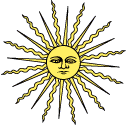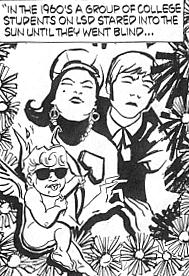Claim: Several students tripping on LSD stared at the sun until blinded.
Origins: This

legend, one the 1960s' most ubiquitous pieces of drug scarelore (along with "teenager on acid trip thinks he can fly and jumps out window") was nothing but pure hoax. Nonetheless, the national print media fell for it twice.
This twisted tale was born on Thursday,
Exclusive to The Times from a Staff Writer SANTA BARBARA — Four college students have suffered permanent impairment of vision as a result of staring at the sun while under the influence of LSD, according to a spokesman for the Santa Barbara Ophthalmological Society. One of the youths told his doctor he was "holding a religious conversation with the sun." Another said he had gazed at the sun "to produce unusual visual displays." The students, all males, suffered damage to the retina, the sensory membrane which receives the image formed by the lens. In the same way that a piece of paper will burn when bright light is beamed through a magnifying glass, a pinhead-size hole was burned into the retina of each eye of the students as sunlight passed through the lens. What this has left the students with is not total blindness but a blind spot in the center of their vision. As a result, the victims have lost their reading vision completely and forever, the ophthalmological spokesman said. "For example, if you wanted to read," he said, "you might see all of the corners of the page and most of the print "If you were to look at a traffic stoplight, you might see the pole and trees and cars — but you wouldn't see the stoplight itself. "That little black hole always moves directly where you want to see," he said. Solar burns of the retina, the spokesman said, are not uncommon, particularly among children watching eclipses of the sun. But he knew of no previous cases which resulted from someone being under the influence of LSD. In the cases here, the victims admitted they were users of LSD. Three of them attend UC Santa Barbara, the other goes to Santa Barbara City College. Their ages range from 18 to 24. The spokesman said it was his impression that each of the sun-staring incidents occurred separately. He did not know whether the students knew each other. The four had no awareness of pain or discomfort while the sun was burning through the eye tissue, the spokesman said. The damage is permanent, because tissue so damaged does not regenerate itself.
FROM SUN GAZING WHILE ON 'TRIP'
Do you recall the first of those six one-word interrogatives all good journalists are supposed to ask? Good.

Now ask yourself, what the heck happened to the who in this story? Not a SINGLE NAME is mentioned anywhere in the article! None of the students is identified, none of the doctors who presumably treated them is named, the ophthamologist quoted at length is never referred to any more specifically than "a spokesman," and even the reporter ("a staff writer") remains anonymous. How is it that this unidentified reporter managed to procure bizarre quotes from the alleged victims (e.g., "I was holding a religious conversation with the sun") yet failed to gather any other basic information, such as the students' names or places of residence? Why is it that no mention is made of the medical facility where these students were presumably treated? How come the "spokesman for the Santa Barbara Ophthalmological Society," who is quoted at length, is never identified?
This story has HOAX written all over it, even before we consider the implausibility of four students' independently staring at the sun until their retinas burned, all on the same day in the same town. (A similar article from the San Francisco Chronicle, also credited to an anonymous "correspondent," mentions that the ophthamologist "would not be identified," and that he "refused to reveal the victims' identity.")
The LSD horror story was picked up by the Associated Press and quickly spread all over the U.S., appearing in such prominent news publications such as The New York Times and Time magazine. One might expect that even though these staid news journals were taken in by the hoax, they learned their lesson when no more details were forthcoming. (We saw, for example, no
WASHINGTON (AP) — Six college men suffered total and permanent blindness by staring at the sun while under the influence of the drug LSD, it was learned Friday. The six, all juniors at a western Pennsylvania college that officials decline to name, lost their sight after they took the hallucinatory drug together last spring. Norman M. Yoder, commissioner of the Office of the Blind in the Pennsylvania State Welfare Department, said the retinal areas of the youths' eyes were destroyed. Federal officials questioned about the case said it is the first they have heard of in which total blindness resulted. The only similar case officials knew of was one reported last May in which four students at the University of California at Santa Barbara suffered permanent loss of their reading vision by staring at the sun after taking LSD. Yoder said in a telephone interview from Harrisburg that the Pennsylvania students all had taken LSD at least once before. He said they went to a grassy area in a woodland about half a mile from the college and took the drug there. Then, he said, they all lay on their backs in the grass "and were not consciously looking at the sun." The youths were found at the scene, blind and helpless, the afternoon of the same day by fellow students who knew of the "trip" plans. Those using the drug had been gone about six hours. Yoder said the youths didn't even realize they were staring at the sun "until they came out of the trance," but that they had come to their senses when the other students arrived. The afflicted students have since been receiving rehabilitation services of the Pennsylvania Welfare Department.
6 College Men Take LSD, Blinded by Sun
First of all, notice that the ante has been upped: now there are six students; the victims have been made completely blind; and, as Newsweek described it, this tragedly befell engineering students who were "nice kids, not hippies" (unlike those California freaks who blathered on about having "religious conversations with the sun"). And once again, there's that nagging non-specificity of detail: the students, their school, their rescuers, the doctors who treated them, and the medical facility where they were taken are all unnamed. The spokesman is identified this time, but as we're about to see,
source.
Although the incident in Pennsylvania was reported as a breaking news story, it had allegedly occurred
Some sensible skeptics managed to make themselves heard, however. Ophthamologists expressed their doubts that even LSD could override self-preservation instincts long enough to keep a person's eyes focused on the sun until retinal tissues burned, or that such an occurrence could have remained unreported twenty months later. And when investigators began to check on the case reports offered by
As usual, the unraveling of the legend received far less attention from the press than its sensational outbreak had produced, and it remained a widely believed drug horror story throughout the next decade. (Newsweek reluctantly printed a tiny retraction in response to a reader who wrote them that "the entire affair was the
No instances of blindness have been shown to result from LSD use, but, of course, there are millions of blind people and hundreds of known causes of blindness which the public and press have shown much less concern about than the propaganda associating LSD with this severe disability. The propensity of the mass media uncritically to accept lurid and sensationalistic stories emanating from generally untrustworthy and uninformed government sources is probably far more dangerous to our social fabric than LSD. Printers' ink in one sense is the most dangerous chemical in use.
Sightings: In episode #36 of Dragnet 1967,
Last updated: 29 January 2007
 Sources:
Sources:
 Also told in:
Also told in:
The Big Book of Urban Legends.New York: Paradox Press, 1994. ISBN 1-56389-165-4 (p. 165).
